Viscoelastic Slider Blocks as a Model for a Seismogenic Fault
Abstract
1. Introduction
2. Viscoelastic Slider-Block Model
| Algorithm 1: The switch algorithm to simulate the numerical integration of slider blocks assembled in a chain. |
|
3. Results
3.1. Model Simulation
3.2. Avalanche Statistics and Model Fitting
4. Discussion and Conclusions
Author Contributions
Funding
Institutional Review Board Statement
Data Availability Statement
Acknowledgments
Conflicts of Interest
References
- Kawamura, H.; Hatano, T.; Kato, N.; Biswas, S.; Chakrabarti, B.K. Statistical physics of fracture, friction, and earthquakes. Rev. Mod. Phys. 2012, 84, 839–884. [Google Scholar] [CrossRef]
- Shcherbakov, R.; Turcotte, D.L.; Rundle, J.B. Complexity and Earthquakes. In Earthquake Seismology, 2nd ed.; Kanamori, H., Ed.; Elsevier: Amsterdam, The Netherlands, 2015; Volume 4 of Treatise on Geophysics; pp. 627–653. [Google Scholar] [CrossRef]
- Rundle, J.B.; Turcotte, D.L.; Shcherbakov, R.; Klein, W.; Sammis, C. Statistical physics approach to understanding the multiscale dynamics of earthquake fault systems. Rev. Geophys. 2003, 41, 1019. [Google Scholar] [CrossRef]
- Rundle, J.B.; Stein, S.; Donnellan, A.; Turcotte, D.L.; Klein, W.; Saylor, C. The complex dynamics of earthquake fault systems: New approaches to forecasting and nowcasting of earthquakes. Rep. Prog. Phys. 2021, 84, 076801. [Google Scholar] [CrossRef] [PubMed]
- Shcherbakov, R.; Turcotte, D.L.; Rundle, J.B.; Tiampo, K.F.; Holliday, J.R. Forecasting the Locations of Future Large Earthquakes: An Analysis and Verification. Pure Appl. Geophys. 2010, 167, 743–749. [Google Scholar] [CrossRef][Green Version]
- Tiampo, K.F.; Shcherbakov, R. Seismicity-based earthquake forecasting techniques: Ten years of progress. Tectonophysics 2012, 522, 89–121. [Google Scholar] [CrossRef]
- Shcherbakov, R.; Zhuang, J.; Zöller, G.; Ogata, Y. Forecasting the magnitude of the largest expected earthquake. Nat. Commun. 2019, 10, 4051. [Google Scholar] [CrossRef]
- Shcherbakov, R. Statistics and Forecasting of Aftershocks During the 2019 Ridgecrest, California, Earthquake Sequence. J. Geophys. Res. 2021, 126, e2020JB020887. [Google Scholar] [CrossRef]
- Bak, P.; Tang, C. Earthquakes as a Self-Organized Critical Phenomenon. J. Geophys. Res. 1989, 94, 15635–15637. [Google Scholar] [CrossRef]
- Turcotte, D.L. Self-organized criticality. Rep. Prog. Phys. 1999, 62, 1377–1429. [Google Scholar] [CrossRef]
- Carlson, J.M.; Langer, J.S. Mechanical Model of an Earthquake Fault. Phys. Rev. A 1989, 40, 6470–6484. [Google Scholar] [CrossRef]
- Carlson, J.M.; Langer, J.S.; Shaw, B.E. Dynamics of Earthquake Faults. Rev. Mod. Phys. 1994, 66, 657–670. [Google Scholar] [CrossRef]
- de Arcangelis, L.; Godano, C.; Grasso, J.R.; Lippiello, E. Statistical physics approach to earthquake occurrence and forecasting. Phys. Rep. 2016, 628, 1–91. [Google Scholar] [CrossRef]
- Burridge, R.; Knopoff, L. Model and Theoretical Seismicity. Bull. Seismol. Soc. Am. 1967, 57, 341–371. [Google Scholar] [CrossRef]
- Huang, J.; Narkounskaia, G.; Turcotte, D.L. A Cellular-Automata, Slider-Block Model for Earthquakes. II. Demonstration of Self-Organized Criticality for a 2-D System. Geophys. J. Int. 1992, 111, 259–269. [Google Scholar] [CrossRef]
- Carlson, J.M.; Langer, J.S.; Shaw, B.E.; Tang, C. Intrinsic-Properties of a Burridge-Knopoff Model of an Earthquake Fault. Phys. Rev. A 1991, 44, 884–897. [Google Scholar] [CrossRef]
- Olami, Z.; Feder, H.J.S.; Christensen, K. Self-organized criticality in a continuous, nonconservative cellular automaton modeling earthquakes. Phys. Rev. Lett. 1992, 68, 1244–1247. [Google Scholar] [CrossRef]
- Shcherbakov, R.; Davidsen, J.; Tiampo, K.F. Record-breaking avalanches in driven threshold systems. Phys. Rev. E 2013, 87, 052811. [Google Scholar] [CrossRef]
- Zhang, X.; Shcherbakov, R. Power-law rheology controls aftershock triggering and decay. Sci. Rep. 2016, 6, 36668. [Google Scholar] [CrossRef]
- Turcotte, D.L. Fractals and Chaos in Geology and Geophysics, 2nd ed.; Cambridge University Press: Cambridge, UK, 1997. [Google Scholar]
- Shcherbakov, R.; Turcotte, D.L.; Rundle, J.B. Aftershock statistics. Pure Appl. Geophys. 2005, 162, 1051–1076. [Google Scholar] [CrossRef]
- Shcherbakov, R.; Goda, K.; Ivanian, A.; Atkinson, G.M. Aftershock Statistics of Major Subduction Earthquakes. Bull. Seismol. Soc. Am. 2013, 103, 3222–3234. [Google Scholar] [CrossRef]
- Utsu, T.; Ogata, Y.; Matsu’ura, R.S. The Centenary of the Omori Formula for a Decay Law of Aftershock Activity. J. Phys. Earth 1995, 43, 1–33. [Google Scholar] [CrossRef]
- Ogata, Y.; Utsu, T.; Katsura, K. Statistical Features of Foreshocks in Comparison with Other Earthquake Clusters. Geophys. J. Int. 1995, 121, 233–254. [Google Scholar] [CrossRef]
- Ogata, Y. Statistical-Models For Earthquake Occurrences And Residual Analysis For Point-Processes. J. Am. Stat. Assoc. 1988, 83, 9–27. [Google Scholar] [CrossRef]
- Gran, J.D.; Rundle, J.B.; Turcotte, D.L. A possible mechanism for aftershocks: Time-dependent stress relaxation in a slider-block model. Geophys. J. Int. 2012, 191, 459–466. [Google Scholar] [CrossRef]
- Amendola, A.; Dragoni, M. Dynamics of a two-fault system with viscoelastic coupling. Nonlinear Proc. Geophys. 2013, 20, 1–10. [Google Scholar] [CrossRef][Green Version]
- Jagla, E.A. Aftershock production rate of driven viscoelastic interfaces. Phys. Rev. E 2014, 90, 042129. [Google Scholar] [CrossRef] [PubMed]
- Jagla, E.A.; Landes, F.P.; Rosso, A. Viscoelastic Effects in Avalanche Dynamics: A Key to Earthquake Statistics. Phys. Rev. Lett. 2014, 112, 174301. [Google Scholar] [CrossRef]
- Sakaguchi, H.; Okamura, K. Aftershocks and Omori’s law in a modified Carlson-Langer model with nonlinear viscoelasticity. Phys. Rev. E 2015, 91, 052914. [Google Scholar] [CrossRef]
- Baró, J.; Davidsen, J. Universal avalanche statistics and triggering close to failure in a mean-field model of rheological fracture. Phys. Rev. E 2018, 97, 033002. [Google Scholar] [CrossRef]
- Freed, A.M.; Lin, J. Delayed triggering of the 1999 Hector Mine earthquake by viscoelastic stress transfer. Nature 2001, 411, 180–183. [Google Scholar] [CrossRef]
- Barbot, S.; Fialko, Y. A unified continuum representation of post-seismic relaxation mechanisms: Semi-analytic models of afterslip, poroelastic rebound and viscoelastic flow. Geophys. J. Int. 2010, 182, 1124–1140. [Google Scholar] [CrossRef]
- Pollitz, F.F.; Wicks, C.; Thatcher, W. Mantle flow beneath a continental strike-slip fault: Postseismic deformation after the 1999 Hector Mine earthquake. Science 2001, 293, 1814–1818. [Google Scholar] [CrossRef] [PubMed]
- Freed, A.M.; Burgmann, R. Evidence of power-law flow in the Mojave desert mantle. Nature 2004, 430, 548–551. [Google Scholar] [CrossRef] [PubMed]
- Hetland, E.A.; Hager, B.H. Postseismic and interseismic displacements near a strike-slip fault: A two-dimensional theory for general linear viscoelastic rheologies. J. Geophys. Res. 2005, 110, B10401. [Google Scholar] [CrossRef]
- Burgmann, R.; Dresen, G. Rheology of the lower crust and upper mantle: Evidence from rock mechanics, geodesy, and field observations. Annu. Rev. Earth Planet. Sci. 2008, 36, 531–567. [Google Scholar] [CrossRef]
- Petrillo, G.; Lippiello, E.; Landes, F.P.; Rosso, A. The influence of the brittle-ductile transition zone on aftershock and foreshock occurrence. Nat. Commun. 2020, 11, 3010. [Google Scholar] [CrossRef]
- Lakes, R.S. Viscoelastic Materials; Cambridge University Press: Cambridge, UK, 2009. [Google Scholar]
- Leine, R.I.; Van Campen, D.H.; De Kraker, A.; Van den Steen, L. Stick-slip vibrations induced by alternate friction models. Nonlin. Dyn. 1998, 16, 41–54. [Google Scholar] [CrossRef]
- Leine, R.I.; Nijmeijer, H. Dynamics and Bifurcations of Non-Smooth Mechanical Systems; Springer: Berlin/Heidelberg, Germany, 2004. [Google Scholar]
- Kothari, S.; Shcherbakov, R.; Atkinson, G. Statistical Modeling and Characterization of Induced Seismicity Within the Western Canada Sedimentary Basin. J. Geophys. Res. 2020, 125, e2020JB020606. [Google Scholar] [CrossRef]
- Shcherbakov, R.; Yakovlev, G.; Turcotte, D.L.; Rundle, J.B. Model for the Distribution of Aftershock Interoccurrence Times. Phys. Rev. Lett. 2005, 95, 218501. [Google Scholar] [CrossRef]
- Zhang, L.Z.; Werner, M.J.; Goda, K. Variability of ETAS Parameters in Global Subduction Zones and Applications to Mainshock-Aftershock Hazard Assessment. Bull. Seismol. Soc. Am. 2020, 110, 191–212. [Google Scholar] [CrossRef]
- Shcherbakov, R.; Van Aalsburg, J.; Rundle, J.B.; Turcotte, D.L. Correlations in aftershock and seismicity patterns. Tectonophysics 2006, 413, 53–62. [Google Scholar] [CrossRef]
- Bhattacharya, P.; Phan, M.; Shcherbakov, R. Statistical Analysis of the 2002 Mw 7.9 Denali Earthquake. Bull. Seismol. Soc. Am. 2011, 101, 2662–2674. [Google Scholar] [CrossRef]
- Burroughs, S.M.; Tebbens, S.F. The upper-truncated power law applied to earthquake cumulative frequency-magnitude distributions: Evidence for a time-independent scaling parameter. Bull. Seismol. Soc. Am. 2002, 92, 2983–2993. [Google Scholar] [CrossRef]
- Jagla, E.A. Creep dynamics of viscoelastic interfaces. Europhys. Lett. 2014, 105, 46003. [Google Scholar] [CrossRef]
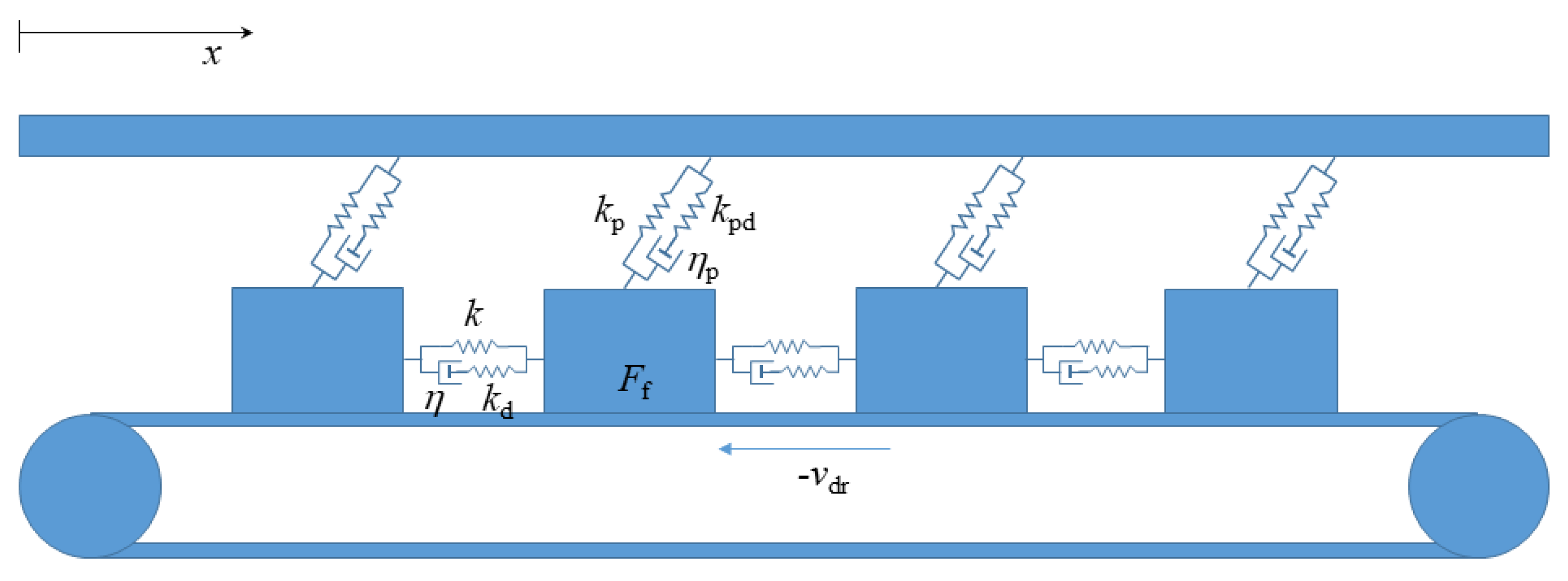
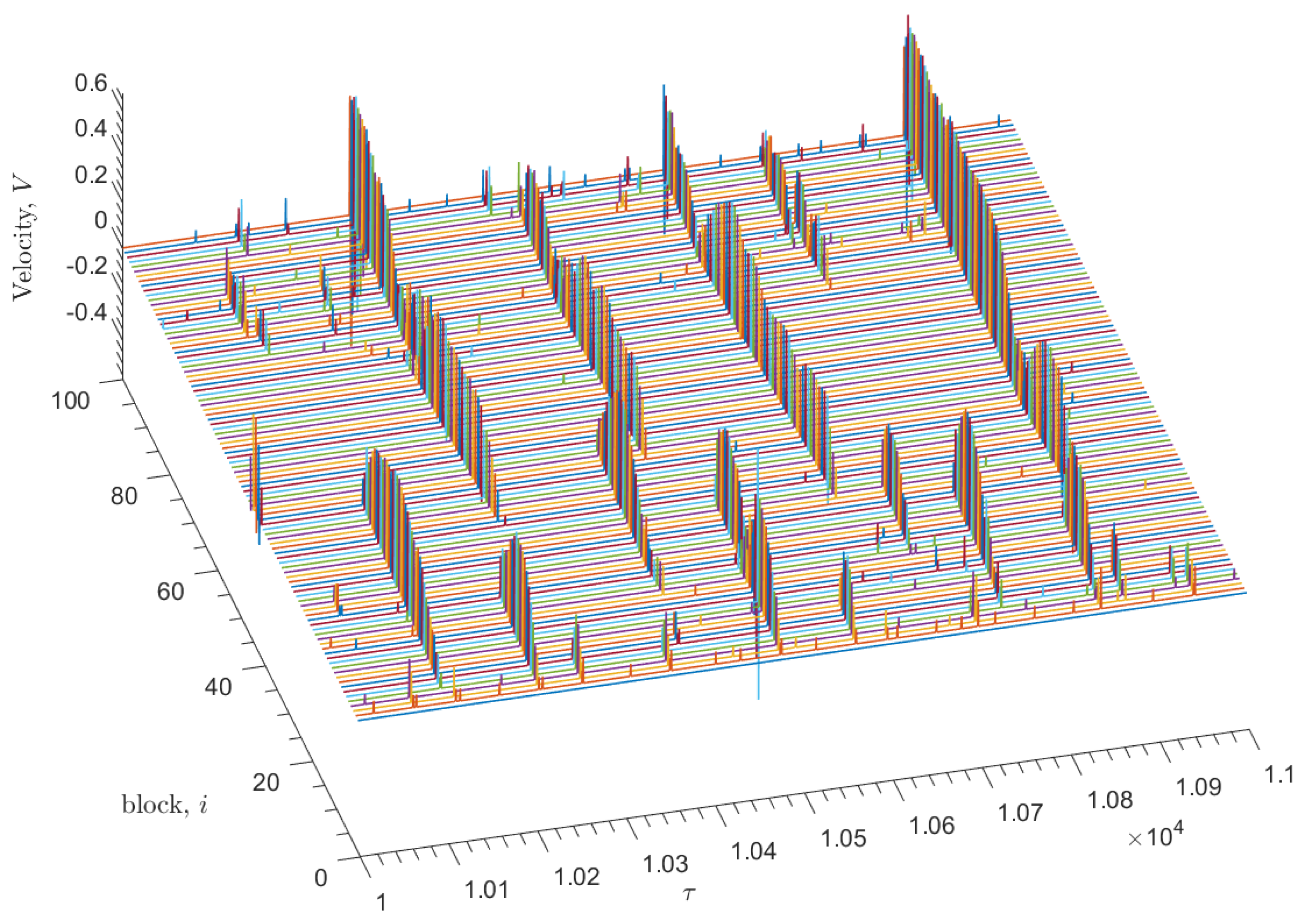
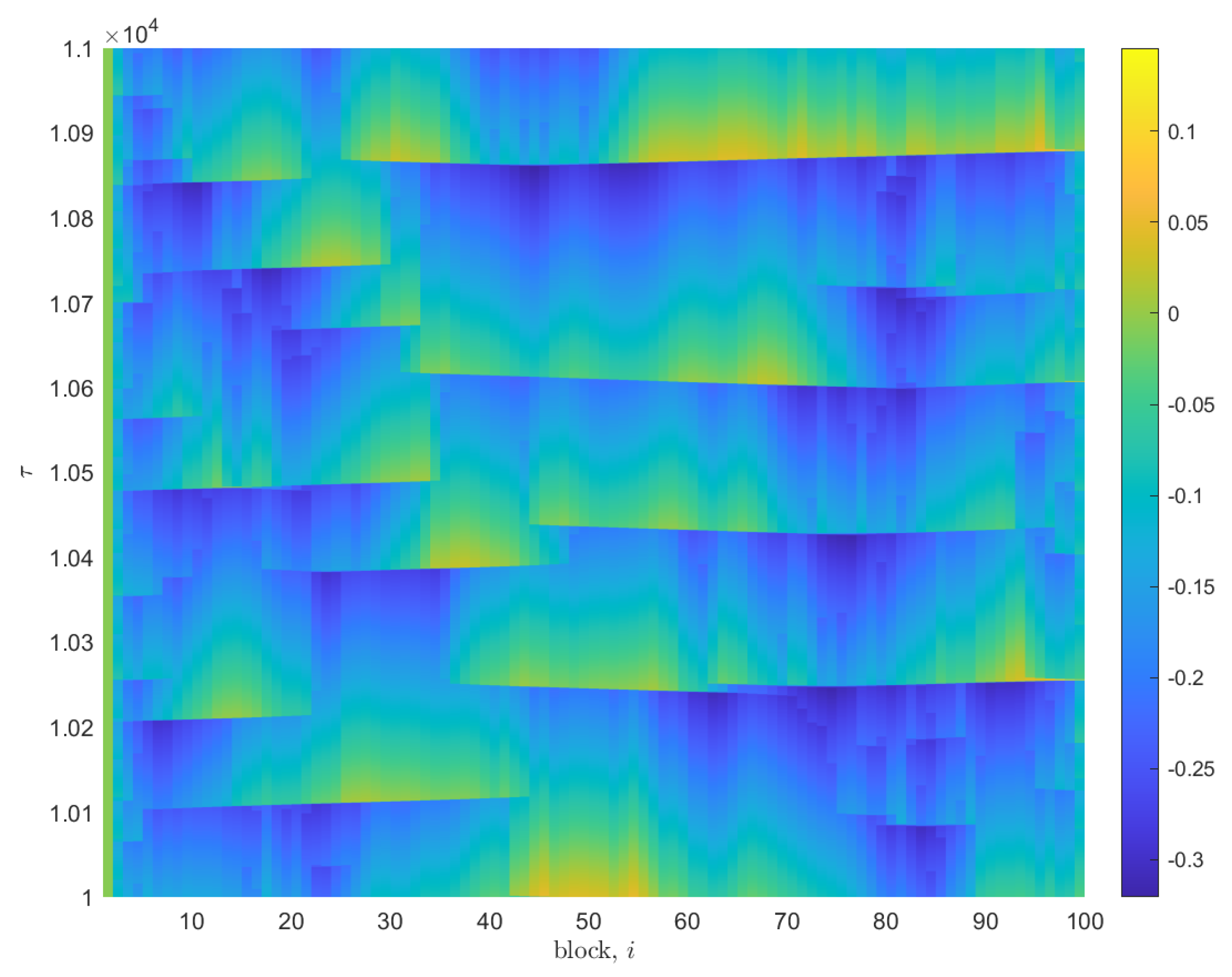
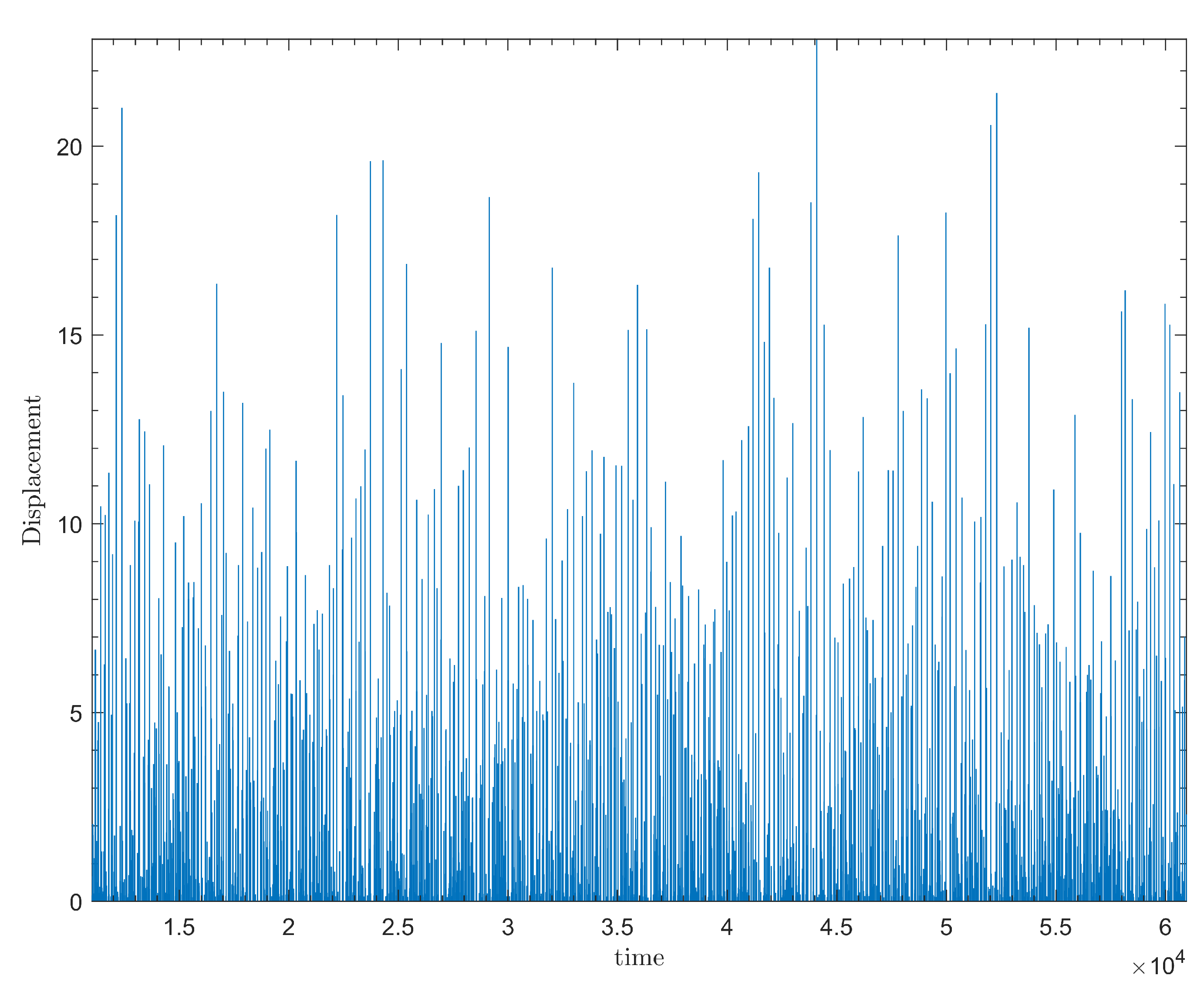

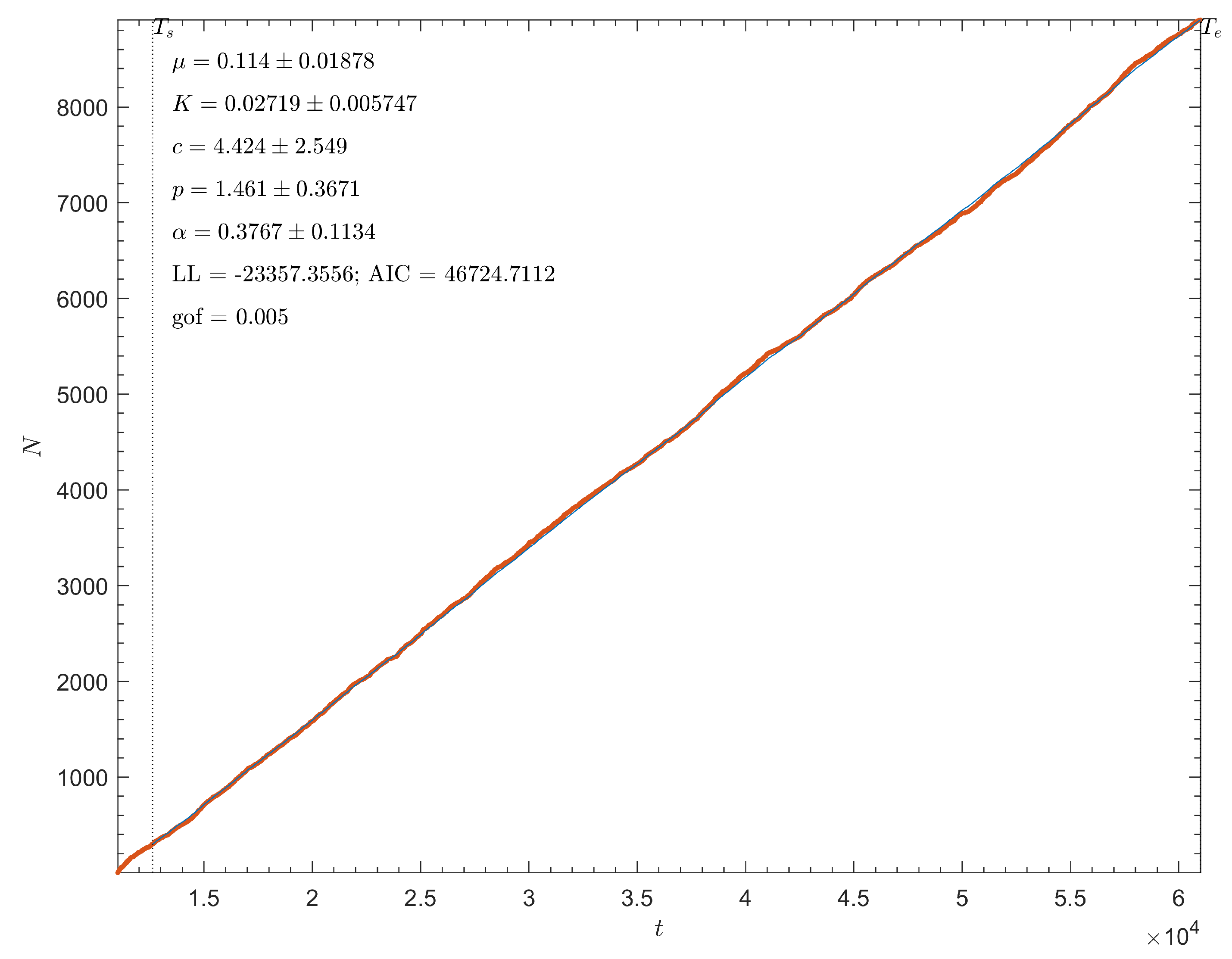
Disclaimer/Publisher’s Note: The statements, opinions and data contained in all publications are solely those of the individual author(s) and contributor(s) and not of MDPI and/or the editor(s). MDPI and/or the editor(s) disclaim responsibility for any injury to people or property resulting from any ideas, methods, instructions or products referred to in the content. |
© 2023 by the authors. Licensee MDPI, Basel, Switzerland. This article is an open access article distributed under the terms and conditions of the Creative Commons Attribution (CC BY) license (https://creativecommons.org/licenses/by/4.0/).
Share and Cite
Motuzas, C.A.; Shcherbakov, R. Viscoelastic Slider Blocks as a Model for a Seismogenic Fault. Entropy 2023, 25, 1419. https://doi.org/10.3390/e25101419
Motuzas CA, Shcherbakov R. Viscoelastic Slider Blocks as a Model for a Seismogenic Fault. Entropy. 2023; 25(10):1419. https://doi.org/10.3390/e25101419
Chicago/Turabian StyleMotuzas, Charlotte A., and Robert Shcherbakov. 2023. "Viscoelastic Slider Blocks as a Model for a Seismogenic Fault" Entropy 25, no. 10: 1419. https://doi.org/10.3390/e25101419
APA StyleMotuzas, C. A., & Shcherbakov, R. (2023). Viscoelastic Slider Blocks as a Model for a Seismogenic Fault. Entropy, 25(10), 1419. https://doi.org/10.3390/e25101419






